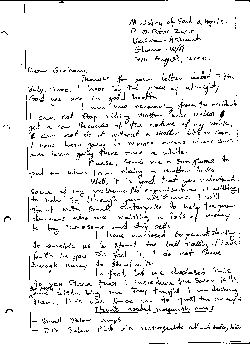| Making Contact Abroad |
 |
Many hundreds of people who have been in contact over the last 6 years and the majority have received both leaflets and a DIY Solar panel sample. In most cases they have shown no further interest. This is not unexpected since those most aware of new 'products' live in towns while this technique is aimed at rural areas. However it certainly has urban possibilities! |
 |
 |
Opposite is part of one of many letters received where interest is certainly shown! In this case sterling notes arrived in a registered envelope and it looks promising. |
 |
| Email Contacts | ||
 |
During the last two years, the spread of computers across the world has eased our task in making new contacts in developing country. We now have a regular eNotice that goes out to about 100 contacts with email, bringing them up to date with the latest developments. |
 |
 |
A simple solar lantern could change life for millions without electricity - New Scientist 22.7.00. DAVID WAIRIMU can finally do his homework. An innovative solar-powered lantern allows him to carry on working when it gets dark. "My position in class is much better since we got it," he says. David, who is 14, lives with his mother Margaret in a mud-walled hut in Engashura, rear the town of Nakuru in Kenya. Electric lights gleam in Nakura, but Kenya’s ramshackle electricity grid does not reach 90 per cent of the country’s homes, including those in Engashura. Until last January, the family’s only light at night was a hurricane lamp burning kerosene. "It was too dark to read by," says David, who proudly displays his new hand-held lantern and points out the cable connecting it to the solar panel on their thatched roof. "We recharge during the day, and that provides electricity for an evening’s light," says Margaret. The Glowstar lantern is the brainchild of a British non-profit consultancy called Inter mediate Technology Consultants. After trials in Kenyan homes, the lamp was launched commercially this month. The hope is that it will do for rural African lighting what the clockwork radio has done for its listening—provide a cheap, reliable, ecologically friendly product that does not require mains power, expensive batteries or kerosene. The solar lantern kit, which costs around £70, is a purpose-built sealed unit containing its own rechargeable battery. What makes it unique is a new type of microchip charge regulator. Its designer, Kieron Crawley, says the regulator will be the key to its success, where other attempts to harness solar power have failed. Around 150 000 Kenyan households have tried using solar panels to charge up car batteries and run portable TVs and lights, but many have abandoned the equipment as batteries became exhausted owing to the use of poorly designed charging circuits. ITC’s microprocessor based charge-control circuit housed inside the lantern constantly monitors the battery to ensure it remains charged. At night it will switch the lantern off rather than allow the battery to go flat, and it can control how much solar energy is conveyed from the solar panel to the battery during the day. "Existing systems don’t do this effectively," says Crawley. "As a result, performance gradually drops off and within six months the system is dead." There have been teething problems during the lantern’s pilot phase. "When the battery runs down the chip loses its memory and the whole thing has to he reprogrammed back in the UK," says Bernard Osawa of Nairobi consultancy Energy Alternatives, which has audited the pilot. But Crawley is confident the problems have been sorted out. Few doubt that solar power has massive potential in rural areas of the developing world that are excluded from national electricity grids. After all, millions of children like David are waiting to do their homework. Fred Pearce, Nairobi BioDesign Analysis We assume that the battery used is a lead-acid type already produced in Kenya. All such batteries are sensitive to treatment, unlike more expensive imported NiCds, and this was the main problem to overcome. What is not mentioned is that ITPower decided to redesign the whole solar lamp when there are perfectly good existing designs - except for the lead-acid battery? Although it might well be viable in some places, in poor areas people will always require a loan for such an outlay and banks are very reluctant to get involved for obvious reasons! As with the clockwork radio, it is unfortunate that the brilliant essential idea has been misused! With the radio, which the BBC refused to approve, the motor would have been far more useful produced as a way to power any existing radio. With the solar lamp, how invaluable it would be if a low-cost way of controlling the charging of ALL car batteries were available! Kristen Cammarata kcammarata@ma.peacecorps.gov in Morocco hashad some encouraging results with our 3w solar lamp and intends to do proper testing of number of these DIY Solar hurricane lamps. Our approach is quite different! These are low power fluorescent to give a little more light than a wick lamp (just enough for reading) but eliminate the problems of fumes, fire and fuel. It will be possible to start with a minimum cost kit of components to assemble a lamp giving a small period of light each evening. But with the economy in paraffin, it will then be possible to buy and fit larger NiCds to give up 5 hours per evening or more! These will start at about £10 + overheads such as customs duty. Apart from projects already announced, others are now planned for Gambia, Nigeria, Tanzania and Bolivia. We still have not found someone to provide the power to run water pump tests. It will need about 10w per pump. |
 |
Home Page